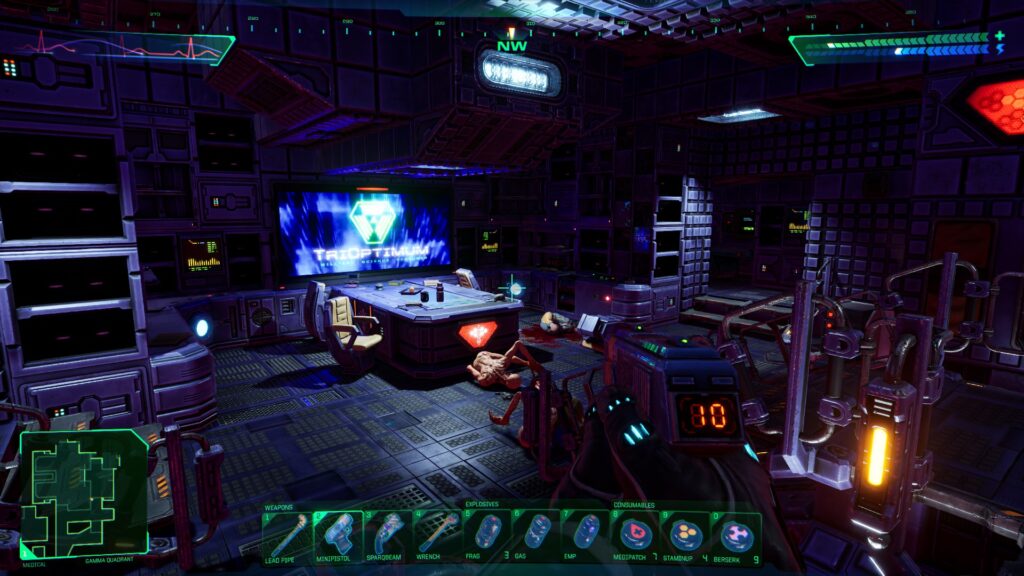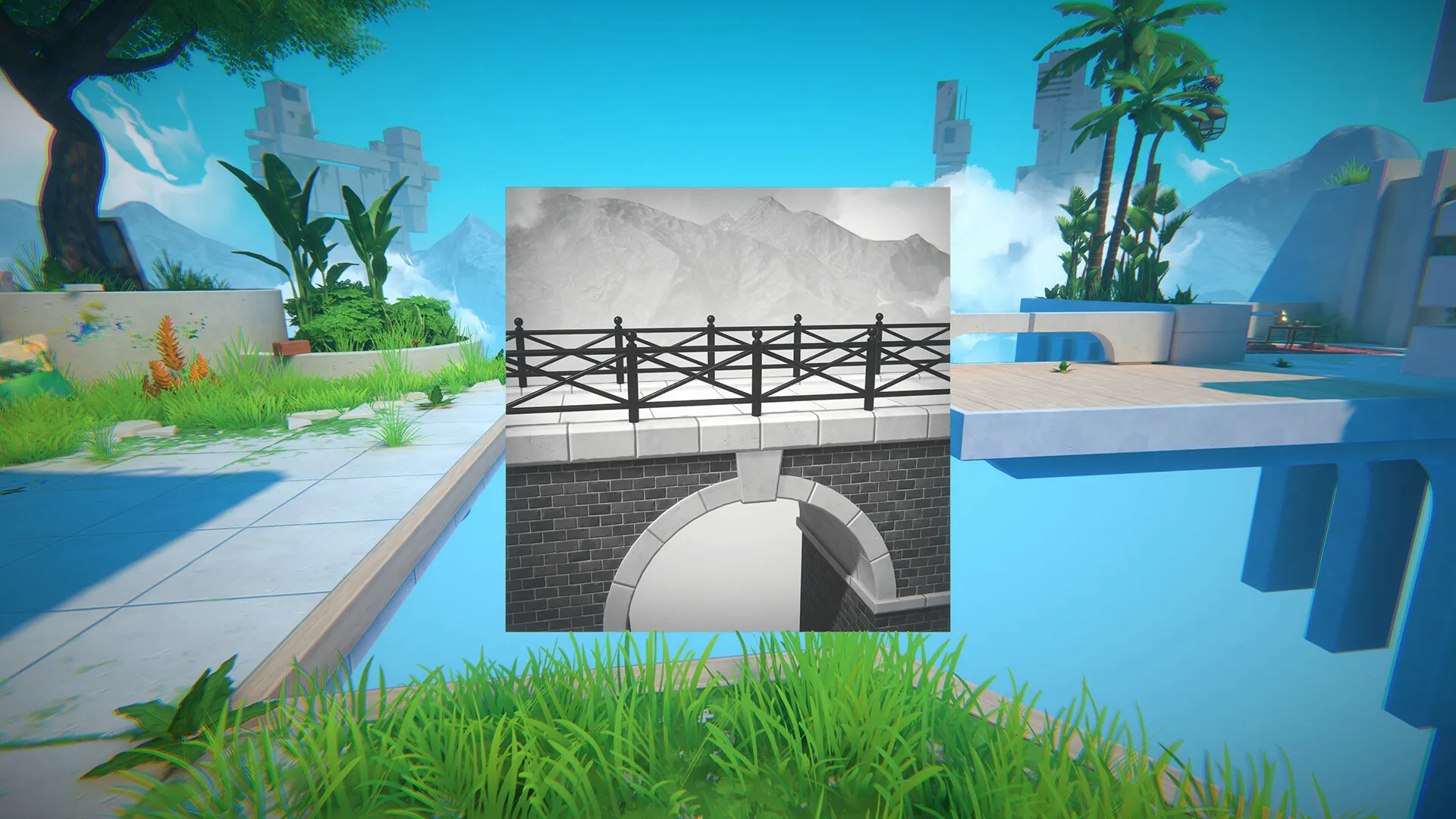REMEMBER CITADEL is scrawled in blood red lettering on the metallic wall of the Von Braun, humanity’s first faster-than-light starship. Featured in System Shock 2 released in 1999, this small bit of worldbuilding probably passed a lot of players by at the time, perhaps unaware it referred to Citadel Station, the setting of the first game. System Shock original only sold 170,000 copies at launch in 1994, so the number of people who actually played the predecessor was relatively small.
In the time since though and particularly after the release of spiritual successor BioShock in 2007, System Shock took on the mantle of being a seminal sci-fi classic, acting as the inspiration for a whole genre of games which came after it; the rather poorly defined and poorly named category of “immersive sim”. Remaking this complex and somewhat clunky game was quite the undertaking from Nightdive Studios, especially given the lengthy development, having been Kickstarted in 2016. Seven years later, the game is finally here on PC.
System Shock is a surprisingly faithful remake of the original game, taking the same story, same setting and a lot of the same level layouts, although with considerable other updates and improvements. It is set aboard Citadel Station in the year 2072. You play as an unnamed hacker, arrested after trying to break into the mainframe of the TriOptimum Corporation, the company which owns the space station. You’re given a deal by Vice President Edward Diego; in exchange for hacking into Citadel Station and disabling the central AI’s ethical subroutines, all charges would be dropped and you’d be given a free military-grade neural interface upgrade.
After doing so, you’re placed in suspended animation for six months, awaking in the Healing Suites aboard Citadel Station in orbit around Saturn. In the intervening time the central AI, SHODAN, has gone rogue, killing most of the station’s crew and transforming those who remain into mutants or cyborgs. It’s up to you to try to stop her nefarious plot to fire the tachyon mining laser towards Earth, as well as releasing a mutagenic virus.

The story is predominantly conveyed via audio logs from deceased members of the station’s personnel, as well as announcements from SHODAN, as she makes her displeasure clear the more you impede her plans. Voice acting has certainly improved on all of the logs since the original literally used members of the development team to do the voice work, and having a professional cast certainly improves delivery. SHODAN is just as iconic as ever; Nightdive rehired Terri Brosius to provide her voice, since she was certainly the stand-out performance in both of the earlier games. Her performance was absolutely a major reason SHODAN became so iconic, and she expertly brings her to life yet again.
If you’ve played BioShock, you’ll be very familiar with this style of gameplay. At first armed with a trusty pipe but soon followed by an assortment of other weapons, you roam the corridors and floors of Citadel Station, listening to audio logs, solving wiring puzzles, picking up items and slaying enemies. The game is pretty undirected, in that although the audio logs will vaguely point you in the direction of what you’re supposed to do next, there is no quest log or arrow to help find and track objectives, requiring the player to engage their brain.
You traverse around the station using the elevator system, although you can’t always use the same elevator to change multiple floors. Broadly, the labyrinthine and intricate interiors of the station have often been transferred directly from the original game, albeit with many new licks of paint. Exploring a floor means not only having to fight an array of monsters and robots, it also means trying to keep yourself oriented within the deliberately complex layout of the station. Thankfully, the improved graphics definitely aid orienteering, providing some memorable locations from which to establish yourself. You’ll also want to keep an eye out for SHODAN’s cameras and destroy them, which gradually helps to lower the security level.
Combat is clearly an area where the game has hugely evolved since the original. The Doom-esque 2D sprites are gone, replaced by fully-3D animated characters. The range of these is surprisingly vast, with most floors introducing new enemies you won’t have previously encountered. From humanoid mutants (the devolved remnants of the station’s crew) to converted cyborgs, to security robots and giant floating viruses (which are invisible until you get close to them), a lot of things want you dead. Thankfully, you do have an arsenal to protect you.

The shooting for the most part feels satisfying and weighty, starting you off with the underpowered Minipistol before introducing better weapons such as a Flechette Shotgun, SparqBeam (think ray gun) and the Mag-Pulse Rifle. Something the player must regularly consider is their stock of ammo, given enemies tend to only drop small amounts and ammo in the environment is fairly scarce. It results in this tense battle of needing to kill enemies, but wanting to use as few resources as possible to do so. You can stealth attack some enemies, but others are much more difficult to catch unaware.
A new feature introduced and borrowed from System Shock 2 is the recycler. On most floors you’ll find a machine where you can convert broken weapons and pieces of scrap into TriOptimum credits. Almost anything in the environment can be converted into scrap, except functioning weapons and medical patches. Credits can then be used at various vending machines around the station, either containing food or medical items to heal you, or sometimes weapon upgrades and ammunition. Being able to upgrade your weapons or buy additional medical patches definitely provides an incentive to scrapping things, although all vending machines have a set limit of items and can’t be farmed indefinitely.
As you explore you’ll also find computer hardware upgrades for your neural interface, which provide a variety of bonuses. Some of these are passive, such as the minimap tool or your biological systems monitor. Others can be activated at the cost of your electrical energy, such as a head-mounted lantern to illuminate dark areas, or the Energy/Projectile Shield, to protect you from incoming fire. You’ll want to keep track of where energy recharging stations are, as you’ll need battery packs to recharge otherwise.
The final core aspect of gameplay is exploration of cyberspace. Throughout the game there are a variety of doors or systems that are locked until they are released by diving into a cyberspace terminal to hack them open. This was something very innovative in the original game but was confusing to play, due to the graphics looking like a mixture of TRON and Atari’s Battlezone. Now the look of cyberspace makes it much easier to navigate, and the combat while in the computer feels more satisfying, almost like a bullet-hell shooter on some occasions.

The aesthetic of the game was a bone of contention during the development process, as originally Nightdive envisaged something very different from the style of the original, which had to be abandoned. In the end, the look is what I might term “high-fi low rez”, where the environments and objects are nicely detailed, but still have that kind of pixelated old-school look to them. It’s a style that works extremely well, and each floor of Citadel Station has a different style, which results in a different atmosphere. The Reactor level for example has loads of wide red corridors, while the Maintenance level has dingy orange hallways. Compared to the original, many areas of the station are a lot darker and more atmospheric, leaning into the horror to a greater degree, as System Shock 2 did.
Finally it’s also worth mentioning the music. The original game has some absolutely rocking MIDI creations; very memorable and high tension, full of guitar and drums. It was however often very loud in the mix, and meant it was often difficult to build tension. Thus most of the music has been completely redone, with a variety of more sombre, atmospheric and moody pieces, alongside long stretches without music. Long time fans will be pleased to know however that the original elevator music between decks has been retained, and is still glorious.
System Shock is an example of a remake done right; preserving the stuff that didn’t need to be changed, while making various quality of life, gameplay and visual improvements. It has clearly been a labour of love for Nightdive Studios over the long seven years of development, and that time and attention to detail is clearly on display. Of all the video game remakes that have been created thus far, this is probably one where the longest time has elapsed since the original release, almost 30 years.
I was a mere 5 years old when System Shock original was released, and I didn’t play it until I was in my 20s, now in my mid-30s. Most of the developers of the game are now in their 50s and 60s. For the time, it was utterly groundbreaking. System Shock remake isn’t groundbreaking, but it is nonetheless a considerable achievement. It will hopefully be the kind of remake which inspires a new generation to delve back into these classic games, and opens their imagination to create new innovative experiences of their own.





